Soft metal


Bartolomé Quesada Valles
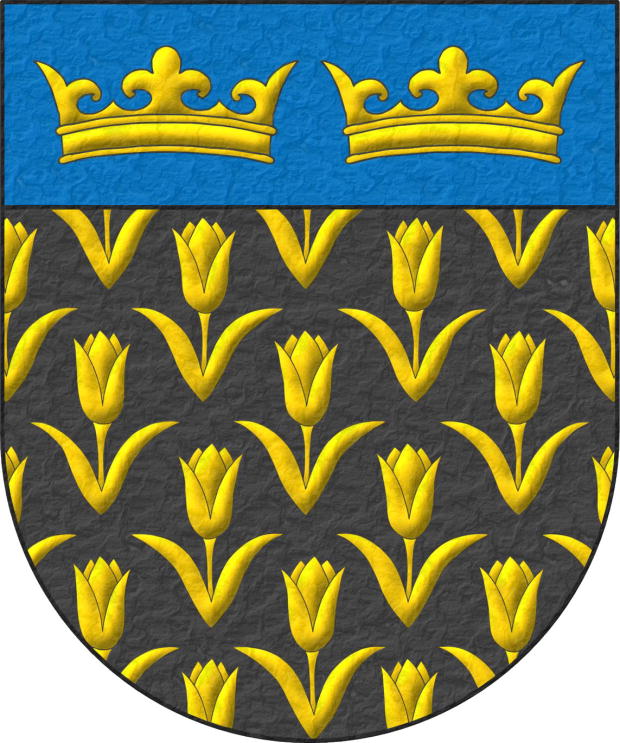
Sable, semé of Tulips Or; on a chief cousu Azure, two Crowns Or, in fess.
Escudo de sable, sembrado de tulipanes de oro; el jefe cosido de azur, dos coronas de oro, en faja.
Blazon keywords: Without divisions, Sable, Or, Azure, Chief, Two, Crown, In fess, Semé and Tulip.
Style keywords: Soft metal, Semi-circular, Illuminated, Outlined in the field tincture, Outlined in sable and Cousu.
Classification: Coat of arms, Created and Personal.
Bearer: Quesada Valles, Bartolomé.


Baudry in France
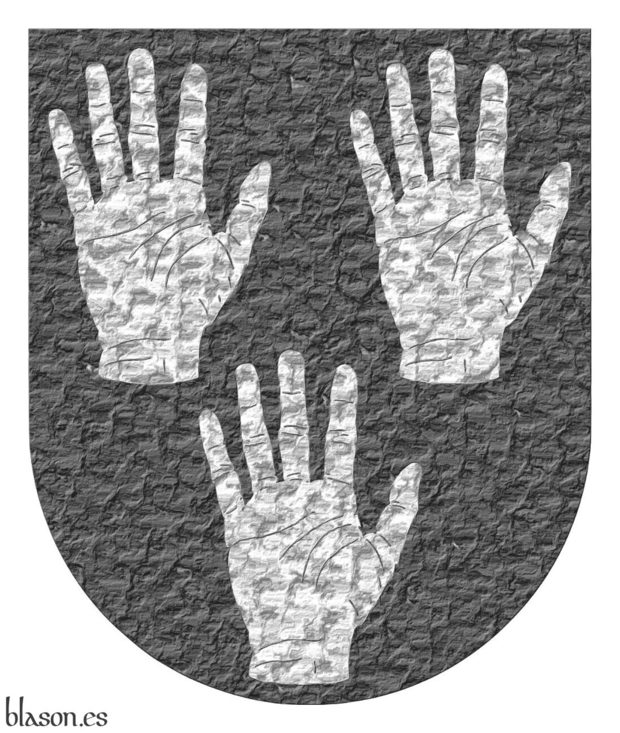
Sable, three dexter hands turned up, and appaumée Argent.
Escudo de sable, tres manos diestras levantadas y apalpadas de plata.
Coat of arms interpreted based on blazon and explanations of [Avilés, J.; 1725a; pages 34 y 35 y sheet 2 figure 38].
Blazon keywords: Without divisions, Sable, Three, Hand, Dexter, Argent, Turned up, Appaumée and Ordered.
Style keywords: Semi-circular, Plain tincture, Outlined in the field tincture and Soft metal.
Classification: Interpreted, Personal and Kingdom of France.
Bearer: Baudry en Francia.


BPAC I
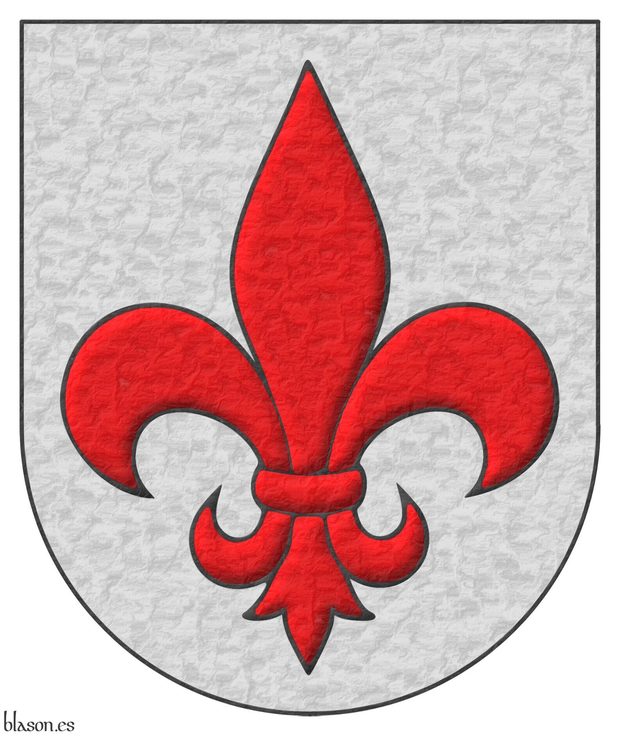
Flag «Roger de Flor», Paratroopers I, assigned to the «Almogávares» VI Paratrooper Brigade of the Spanish Army.
Argent, a fleur de lis Gules.
Escudo de plata, una flor de lis de gules.
Coat of arms interpreted with: a semicircular (round) base; a fleur de lis outlined in Sable and illuminated in Gules; and an overall lightly-hammered metal finish.
Blazon keywords: Without divisions, Argent, Gules and Fleur de lis.
Style keywords: Semi-circular, Illuminated, Outlined in sable and Soft metal.
Classification: Interpreted, Military, Army and Navy and Coat of arms.
Bearer: BPAC I.


BPAC II
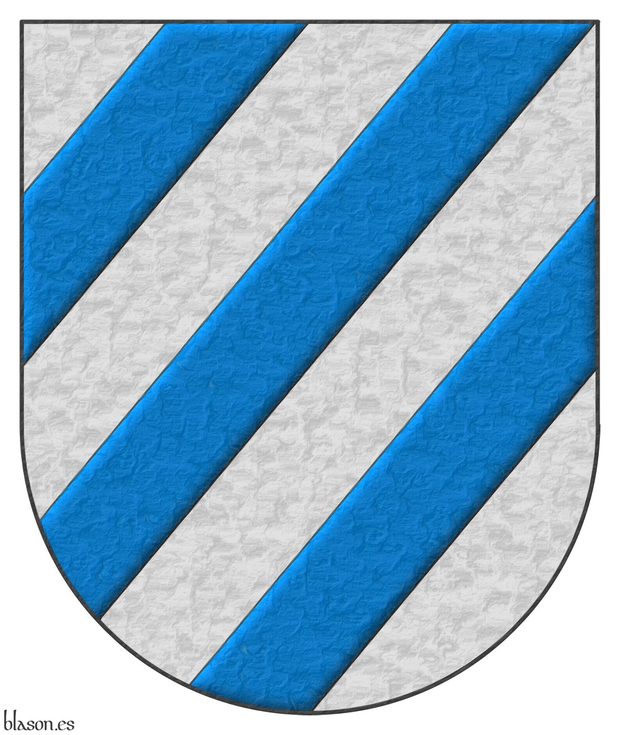
«Roger de Lauria»,' 2nd Paratrooper Battalion, part of the «Almogávares» VI Parachute Brigade of the Spanish Army.
Argent, three bendlets sinister Azure.
Escudo de plata, tres barras de azur.
For this interpretation, I have used: an exterior shape ending in a semicircular arch; my usual angle of 50.2o = arctan(6/5), as tangent = opposite side / adjacent side; a division similar to that used by the Spanish Army for this coat of arms, which relies on dividing the height of the shield into 4 segments; and for the whole, a finish of lightly hammered metal
Blazon keywords: Without divisions, Argent, Azure and Bend sinister.
Style keywords: Semi-circular, Illuminated, Outlined in sable and Soft metal.
Classification: Interpreted, Military and Army and Navy.
Bearer: BPAC II.


Carlos de la Cerda
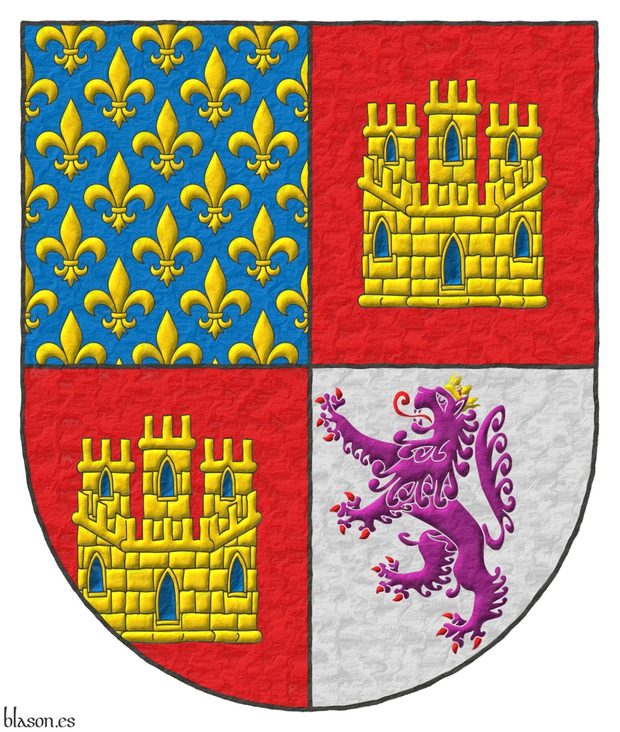
Quarterly: 1 Azure semé of fleurs de lis Or; 2 and 3 Gules, a castle triple towered Or, the port and windows Azure, masoned Sable; 4 Argent, a lion rampant Purpure, armed and langued Gules, crowned Or.
Escudo cuartelado: 1o de azur sembrado de flores de lis de oro; 2o y 3o de gules, un castillo de oro, aclarado de azur, mazonado de sable; 4o de plata, un león rampante de púrpura, armado y lampasado de gules, coronado de oro.
Blazon keywords: Quarterly, Azure, Semé, Fleur de lis, Or, Gules, Castle, Port and windows, Masoned, Sable, Argent, Lion, Purpure, Rampant, Armed, Langued, Crown and Crowned.
Style keywords: Semi-circular, Illuminated, Outlined in sable and Soft metal.
Classification: Interpreted, Personal, Army and Navy and Kingdom of France.
Bearer: Cerda, Carlos de la.


Cavalry Regiment Alcantara, royal crown
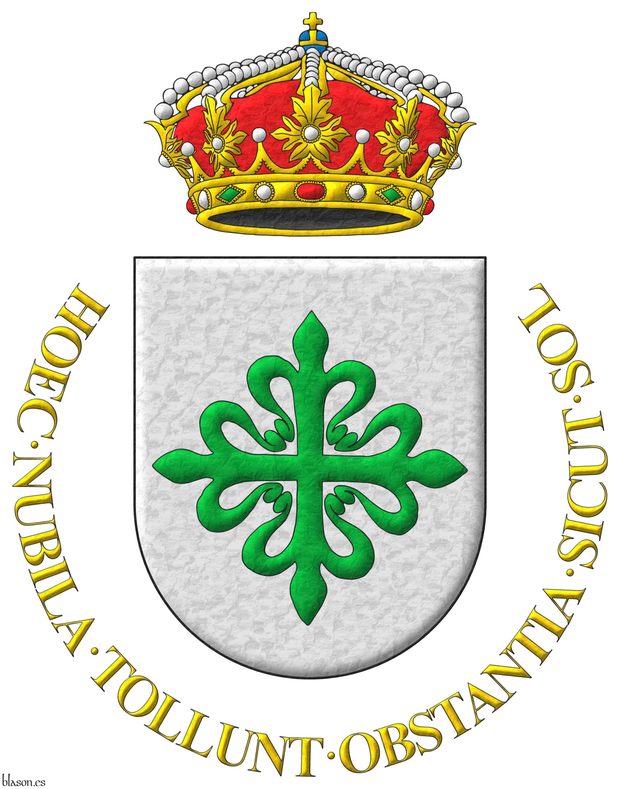
Disperse like the sun clears the clouds in your path.
Argent, a cross of Alcantara. Crest: A closed royal crown Or, with eight arches, visible five. Motto: «Hoec nubila tollunt obstantia sicut sol».
Escudo de plata, una cruz de Alcántara. Timbrado de una corona real cerrada. Lema: «Hoec nubila tollunt obstantia sicut sol».
Coat of arms interpreted in the following manner: the shape of the shield is of a semicircular arch; the field is illuminated in metal Argent; the cross of Alcantara is outlined in Sable and illuminated in Vert; the royal crown is closed, outlined in Sable and illuminated with the metal Or, Argent for the pearls, Azure and Or for the orb, Gules and Vert for the gems, Gules for the inner cloth, and Sable for the visible hollow at its base; and the whole has a slightly hammered metal finish.
Regiment's Motto
The Latin motto «Hoec nubila tollunt obstantia sicut sol» is often translated as «Ride like the sun, disperses the clouds in its path». I would like to offer the following observations on this translation:
- Instead of «disperse», I prefer the verb «scatter» which is more aligned with a cavalry regiment, [Royal Spanish Academy; 2001] «scatter, 3rd meaning, transitive verb, military term: To break up, rout the enemy, causing them to flee and scatter in complete disorder».
- On the other hand, even though it is about cavalry, I do not find that the Latin motto makes reference to riding, a verb that is also not needed to understand the motto's meaning, and adding an extra word lengthens the motto, reducing its impact.
- Finally, I use «your», instead of «its», so that the motto is a direct and personal rallying cry and not a phrase directed at a third person.
Blazon keywords: Without divisions, Argent, Cross of Alcantara, Cross couped, Cross, Crest, Closed royal crown, Crown and Motto.
Style keywords: Semi-circular, Illuminated, Outlined in sable and Soft metal.
Classification: Interpreted, Military, Army and Navy and Coat of arms.
Bearer: Alcantara, Cavalry Regiment.


Cavalry Regiment Montesa, royal crown
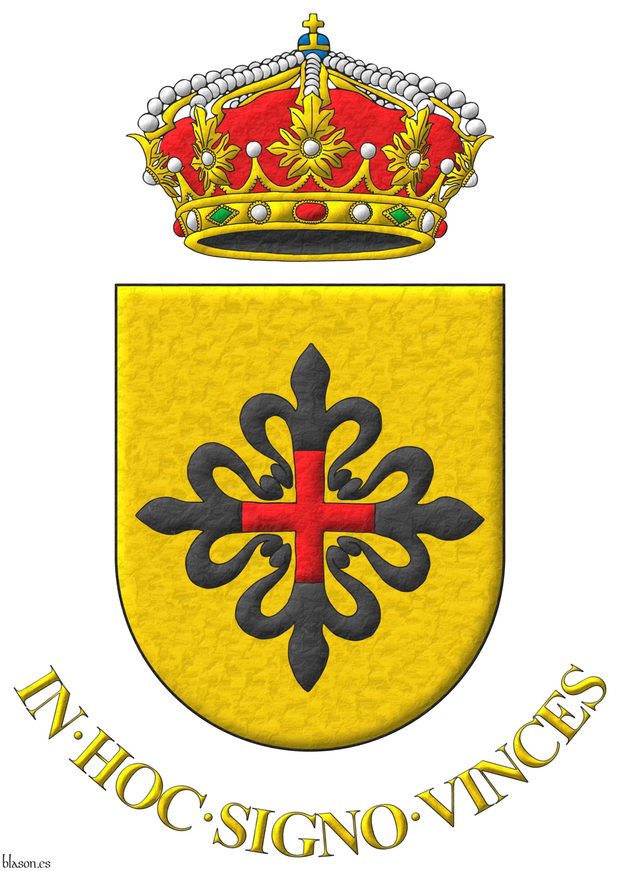
In this sign, you shall conquer.
Argent, a cross of Montesa. Crest: A closed royal crown Or, with eight arches, visible five. Motto: «In hoc signo vinces».
Escudo de oro, una cruz de Montesa. Timbrado de una corona real cerrada. Lema: «In hoc signo vinces».
Coat of arms interpreted as follows: the shape of the shield is a semi-circular arch; the field has been illuminated in metal Or; the cross of Montesa is outlined in Sable and illuminated in Sable and Gules; the royal crown is closed, outlined in Sable and illuminated the metal in Or, the pearls in Argent, the orb in Azure and Or, the gemstones in Gules and Vert, the inner cloth in Gules, and the visible hollow at its base in Sable; and the whole has a slightly beaten metal finish.
Regimental Motto
The Latin motto «In hoc signo vinces» is translated as «In this sign, you shall conquer».
Globus cruciger ~ Orb
It is called orb ~ «globus cruciger», the first in Spanish and the second in Latin, referring to the part of the royal crown, a jewel, or a jewel itself that recreates the shape of the globe topped with a cross.
Blazon keywords: Without divisions, Or, Cross of Montesa, Cross couped, Cross, Crest, Closed royal crown, Crown and Motto.
Style keywords: Semi-circular, Illuminated, Outlined in sable and Soft metal.
Classification: Interpreted, Military, Army and Navy and Coat of arms.
Bearer: Montesa, Cavalry Regiment.


Coat of arms for the Arithmetic
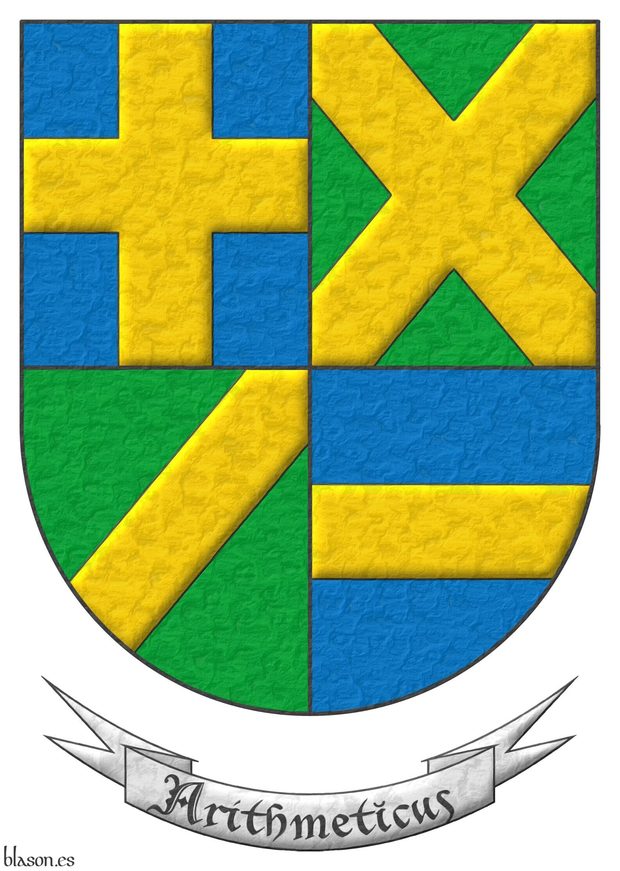
Quarterly: 1 Azure, a cross Or; 2 Vert, a saltire Or; 3 Vert, a bend sinister Or; 4 Azure, a fess Or. Motto: «Arithmeticus».
Escudo cuartelado: 1o de azur, una cruz de oro; 2o de sinople, un sotuer de oro; 3o de sinople, una barra de oro; 4o de azur, una faja de oro. Divisa: «Arithmeticus».
I have made this imaginary coat of arms for the Arithmetic with the following characteristics: a semicircular external shape; its enamelled field with flat color Azure and Vert inks; all the pieces are metal Or, the motto is metal Argent with Sable letters; pieces and motto are illuminated and outlined in Sable; and the whole with a very lightly beaten metal finish.
For the division operation, instead of using the piece bend sinister, 2 bezants Or in pale could have been used. However, since the bezant is a diminished piece, I preferred to use 4 pieces, one for each quarter.
Blazon keywords: Quarterly, Azure, Vert, Or, Cross, Saltire, Bend sinister, Fess and Motto (identification).
Style keywords: Illuminated, Outlined in sable and Soft metal.
Classification: Created, Imaginary and Coat of arms.
Imaginary bearer: Arithmetic.


Coat of arms of Elias Yñigo-Genio
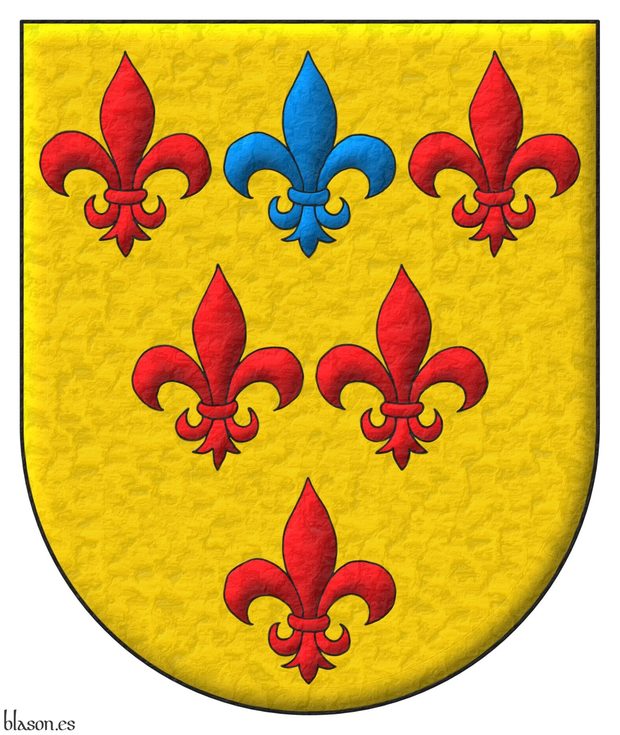
Or, six fleurs de lis, three, two, one, five Gules and one in the middle of the chief Azure.
Escudo de oro, seis flores de lis ordenadas, tres, dos y una, cinco de gules y una de azur en el centro del jefe.
Credits: Rolando Yñigo-Genio is the designer of the coat of arms and Antonio Salmerón y Cabañas is the author of the heraldic art.
Blazon keywords: Or, Six, Fleur de lis, Ordered, Three, two and one, Five, Gules, One, Azure and In the middle of the chief.
Style keywords: Semi-circular, Soft metal, Outlined in sable and Illuminated.
Classification: Interpreted, Personal and Coat of arms.
Bearer: Yñigo-Genio, Elias.


Coat of arms of Rolando Yñigo-Genio
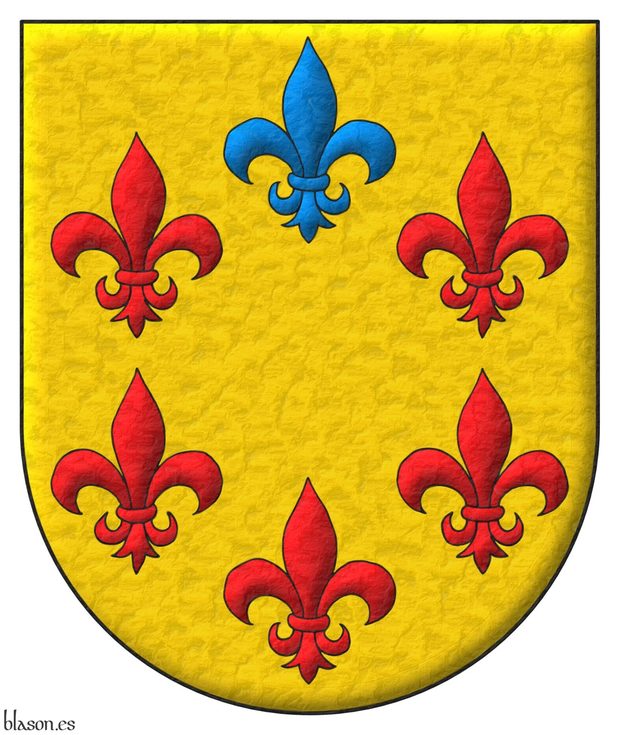
Or, six fleurs de lis in orle, five Gules and one in chief Azure.
Escudo de oro, seis flores de lis en orla, cinco de gules y una de azur en jefe.
Credits:
- Rolando Yñigo-Genio is the designer of the coat of arms.
- Antonio Salmerón y Cabañas is the author of the heraldic art.
Blazon keywords: Or, Six, Fleur de lis, Orle, Five, Gules, One, Azure and In chief.
Style keywords: Semi-circular, Soft metal, Outlined in sable and Illuminated.
Classification: Interpreted, Personal and Coat of arms.
Bearer: Yñigo-Genio, Rolando.


![Ver [Eight-ball, another version with a terrace in base] en criterios utilizados. Unicornio saltante sobre la divisa, criterio.](../css/Unicornio.Criterio.png)
Eight-ball, another version with a terrace in base
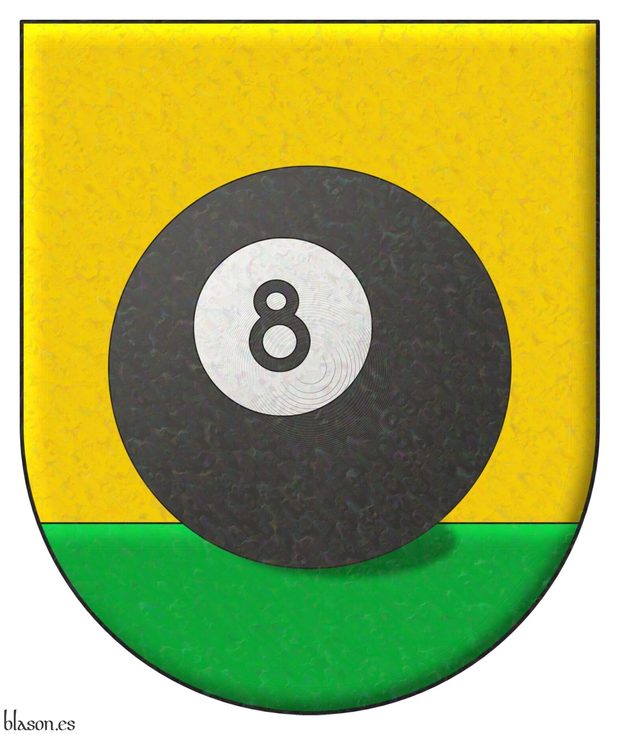
Or, an eight-ball proper on a terrace in base Vert.
Escudo de oro, una bola ocho al natural terrazada de sinople.
Can modern objects appear in a coat of arms?
My rule is: a coat of arms is forever, so any symbol included must be recognizable by future generations. Can you place an iPhone in a coat of arms? No—but not because it’s modern, rather because your grandchildren likely won’t recognize the form of an iPhone; in fact, today’s mobile phones already look quite different from those of a decade ago. Can you include a steam locomotive? Yes, because its form has become anchored in time and in the collective imagination. What about an hourglass, an analog clock, or a black 8-ball from pool? Also yes—their forms are now classics. That is, I believe we can use those symbols that most people already carry in their minds and that are very likely to remain present in the minds of our children and grandchildren. But this is just my humble criterion.
Categories: Criterion, Art, Created, Imaginary, Coat of arms, Semi-circular, Crystalline, Soft metal, Outlined in sable, Illuminated, Without divisions, Or, One, Non-classic artifact, Proper and Terrace in base.
Root: Bola 8.


Enrique Fernández Marqués, Unitas est fortitudo
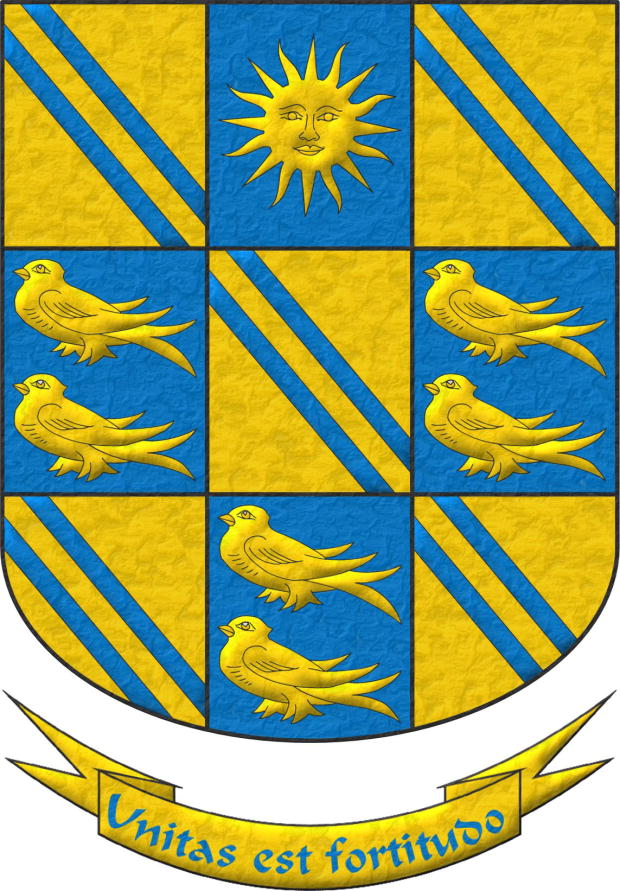
Checky of nine Or and Azure, the checks Or: 1st, 3rd, 5th, 7th, and 9th, two cotises Azure; 2nd, a sun Or; 4th, 6th, and 8th, two martlets Or, palewise. Motto: «Unitas est fortitudo»
Escudo equipolado de oro y azur: 1o, 3o, 5o, 7o y 9o, dos cotizas de azur; 2o, un sol de oro; 4o, 6o y 8o, dos marletas de oro, en palo. Lema: «Unitas est fortitudo»
Coat of arms with its motto that I have created with: the shield mouth rounded; its nine fields enameled in flat tinctures metal Or and color Azure; the rest of the elements illuminated in Azure and Or and outlined in Sable; the motto illuminated in Or and Azure; and the whole assembly with a slightly hammered metal finish.
Blazon keywords: Chequy of nine squares, Or, Azure, Bendlet, Sun in splendour, Martlet, In pale and Motto.
Style keywords: Rounded, Illuminated, Outlined in sable and Soft metal.
Classification: Created, Personal and Coat of arms.
Bearer: Fernández Marqués, Enrique.


![Ver [Heraldic blog of David B. Appleton] en enlaces recomendados. Áncora de oro y la divisa enlace.](../css/Ancora.Enlace.png)
Heraldic blog of David B. Appleton
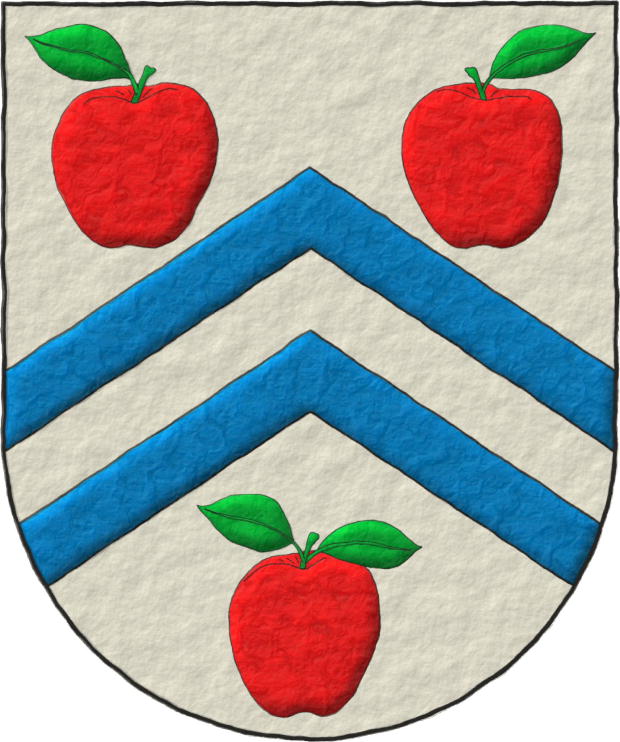
Appleton Studios
David B. Appleton studies, researches, teaches, and writes about heraldry, and through his blog, he shares his heraldic knowledge with us, as well as through publications and presentations.
David B. Appleton is open to questions from his readers and provides advice on heraldic topics in which he specializes.
His blog is Blog.AppletonStudios.com and his website is AppletonStudios.com, from which he offers his services related to the world of heraldry, its dissemination, and knowledge.
Since 2009, David B. Appleton's heraldic blog has been an endless source of knowledge, images, ideas, curiosities, original reflections, and links to heraldic sites selected by him.
Heraldry: Musing on an esoteric topic
David B. Appleton stands out for his continuous analysis of all types of heraldic manifestations, which he finds everywhere, in the world we live in: from those we have inherited from ancient times to the fiercely current, from books to cinema, from fashionable clothing to urban furniture, from east to west and north to south, including those that appear in logos and emblems, those using traditional techniques and those created or disseminated through new technologies, on ships, sports cars, and airplanes, on porcelain, facades, and stained glass, on television, on t-shirts and coins, in auctions and universities, in comics and sports, etc. with a systematic publication rhythm, more than 2 posts per week, nothing heraldic escapes the record and genuine analysis of David B. Appleton on Blog.AppletonStudios.com, which I highly recommend.
Categories: Link, Interpreted, Personal, Coat of arms, Without divisions, Freehand, Soft metal, Illuminated, Outlined in sable, Canting, Heraldry and heralds, Argent, Azure, Gules, Vert, Chevronel, Between, Apple, Slipped and Leaved.
External links:
- Interpretation of his coat of arms.
- Interpretation by Xavier García at Appleton Studios.
- Interpretation by Xavier García at Dibujo Heráldico with his blazon in English and Spanish.
Root: Appleton, David B..


Jamilena, province of Jaen
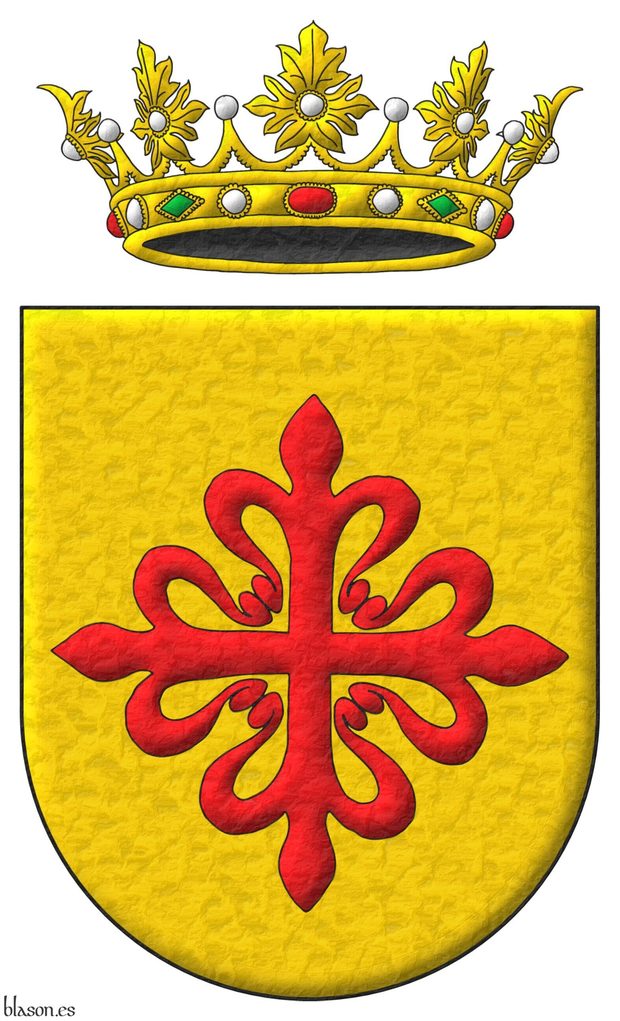
Or, a cross of Calatrava. Crest: An open royal crown Or.
Escudo de oro, una cruz de Calatrava. Timbrado de una corona real abierta.
Coat of arms interpreted as follows: the shield's shape is a semicircular arch; the field is illuminated in metal Or; the cross of Calatrava is outlined in Sable and illuminated in Gules; the royal crown is open, outlined in Sable and illuminated in metal Or, pearls in Argent, gemstones in Gules and Vert, and the visible base hollow in Sable; and the entire piece has a slightly hammered metal finish.
The municipality of Jamilena belongs to the La Campiña region and is the smallest in the province of Jaén. I have depicted its coat of arms with an open royal crown, but representations with a closed royal crown can also be found.
The origin of the cross of Calatrava in its heraldic coat of arms dates back to the year 1525 when Emperor Charles V issued several decrees from Toledo to build a convent for nuns in Jamilena. For the construction of this convent, stones from the Muslim castle, which was reformed and occupied by the Order of Calatrava, were used.
Blazon keywords: Without divisions, Or, Cross of Calatrava, Cross couped, Cross, Crest, Open royal crown and Crown.
Style keywords: Semi-circular, Illuminated, Outlined in sable and Soft metal.
Classification: Interpreted, Civic and Coat of arms.
Bearer: Jamilena.


Kimon Andreou, contourné
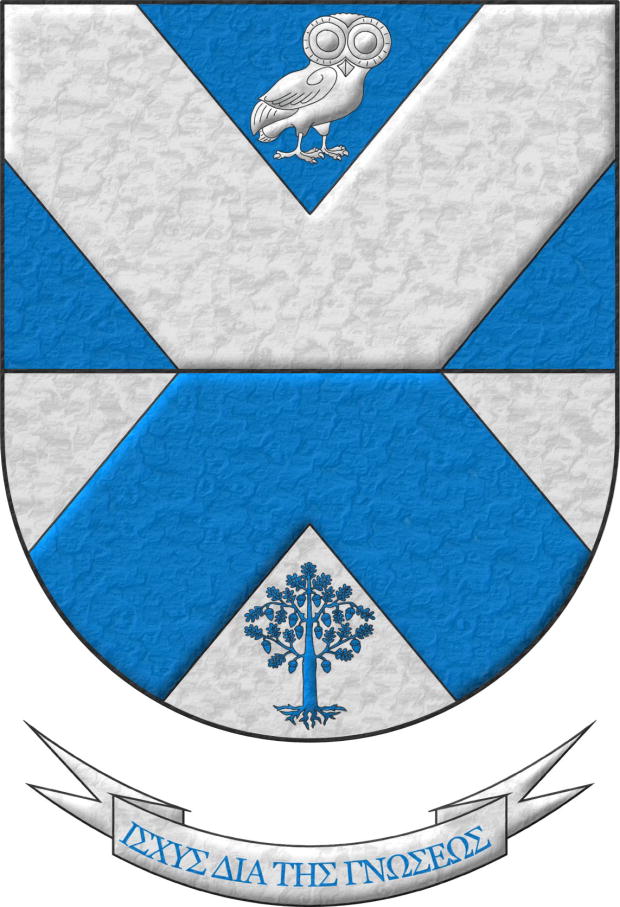
Party per fess: 1 Azure, a Athenian owl Argent, contourné, in chief; 2 Argent, an oak Azure, eradicated, in base; overall a saltire counterchanged. Motto: «Ischys Dia Tis Gnoseos» written in greek.
Escudo cortado: 1o de azur, una lechuza al estilo ateniense, contornada de plata, en jefe; 2o de plata, un roble de azur, arrancado, en punta; brochante sobre el todo un sotuer del uno al otro. Lema: «El poder del conocimiento» escrito en griego.
Existing coat of arms which I have interpreted with: its semicircular (round) base; its 2 fields enameled in plain tinctures Azure and Argent; its saltire with the traditional dimensions of 1/3 of the width of the shield, that is, the width of a bend; its figures outlined in Sable and illuminated in Argent and Azure; its illuminated motto; and the ensemble in lightly beaten metal.
Contourné ~ Contornado
There are authors who limit the use of the term contornado to turned heads that look to the sinister side of the shield. However, here I use contornado in a more general way, following [Avilés, J.; 1780a; page 61] who defines it as «contornados se dice de los animales ú de las cabezas de ellos, vueltos á la siniestra del Escudo».
There is another more specific use of the term contornado for the crescent moon: «bueltos se dice de los Crecientes que miran á el lado derecho del Escudo, porque mirando á el siniestro se dice contornados», [Avilés, J.; 1780a; page 52].
In English, the equivalent term that I have most frequently seen is «contourné», which comes from French.
Blazon keywords: Party per fess, Azure, Argent, Saltire, Overall, Counterchanged, Barn owl, Regardant, Tree, Oak, Erased and Motto.
Style keywords: Soft metal, Illuminated and Outlined in sable.
Classification: Interpreted, Personal and Coat of arms.
Bearer: Andreou, Kimon.


Latidos Podencos with motto
Gules: a warren hound parado statant Or; a base hearty Or. Motto: «Latidos Podencos» Or.
Escudo de gules: un podenco parado de oro; la campaña encajada de corazones de oro. Divisa: «Latidos Podencos» de oro.
Coat of arms that I have designed for the shelter Latidos Podencos as follows: the outline of the shield is pointed and rounded; its field is painted in flat tincture Gules; the motto, its warren hound, and its base of interlocking hearts are delineated Sable and illuminated with the metal Or; and the whole shield has a softly hammered metallic finish.
Heraldic objects
A coat of arms in Or and Gules has been created, with and without motto, together with a seal, a decorative bordure featuring ten hounds and twelve hearts to frame documents, and also a variant of the shield in Argent and Azure for complementary uses.
Blazon keywords: Without divisions, Gules, Or, Warren hound, Dog, Base, Base (lower 1/3), Dancetty, Heart and Motto (identification).
Style keywords: Ogee, Illuminated, Outlined in sable and Soft metal.
Classification: Created, Socioeconomic and Coat of arms.
Bearer: Latidos Podencos.


Navarra, closed carbuncle
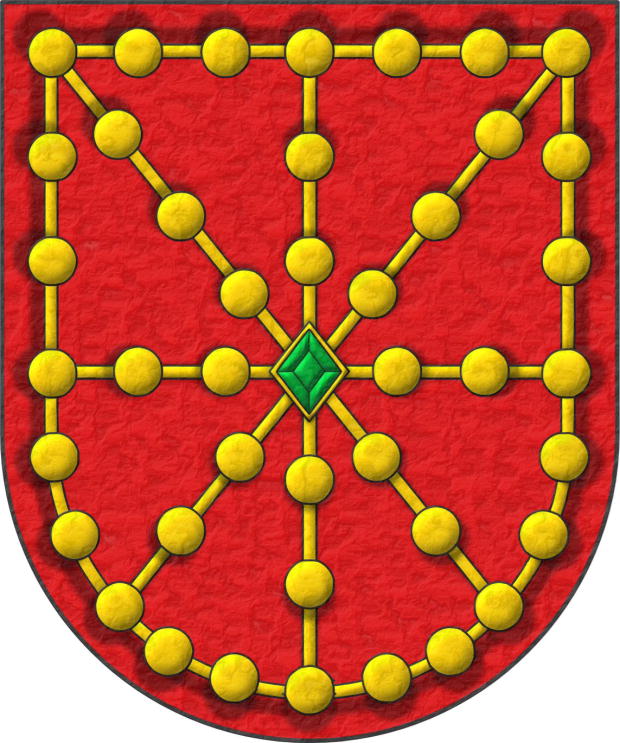
Escudo de gules, un carbunclo cerrado, pomelado de oro; cargado en el centro de una esmeralda en forma de losange de sinople.
Coat of arms interpreted with: a semicircular (round) base; the field in flat Gules; the pommetty carbuncle and the emerald illuminated in Or and Vert, shaded and outlined in Sable; and the whole finished in lightly-hammered metal.
In addition to historical documents such as the armorials [Urfé; 15th century] which blazons it and [Bosque, J. del; 1540] which illustrates it, there is, in the last half century, an abundant bibliography on the arms of Navarre, for example: [Menéndez Pidal de Navascués, F.; 1963], [Menéndez Pidal de Navascués, F.; 1974], [Martinena Ruiz, J. J.; 1982], [Menéndez Pidal de Navascués, F.; 1999], [Menéndez Pidal de Navascués, F.; Martínez de Aguirre, J.; 2000], [Martinena Ruiz, J. J.; Menéndez Pidal de Navascués, F.; 2001] and [Martínez de Aguirre, J.; 2007].
This pommetty shield can also be seen, for example, on the outer façade of the convent of Santo Domingo in Estella, on capitals preserved in the Cathedral of Tudela and on capitals of the church of Santa María la Real of Laguardia, the latter dating from the 14th century.
Blazon keywords: Without divisions, Gules, One, Carbuncle, Pommelled, Or, Charged, In the fess point, Emerald, Vert and Lozenge.
Style keywords: Soft metal, Illuminated, Outlined in sable and Shaded.
Classification: Interpreted, Civic and Coat of arms.
Bearer: Navarre.

Nhf, Norsk Heraldisk Forening
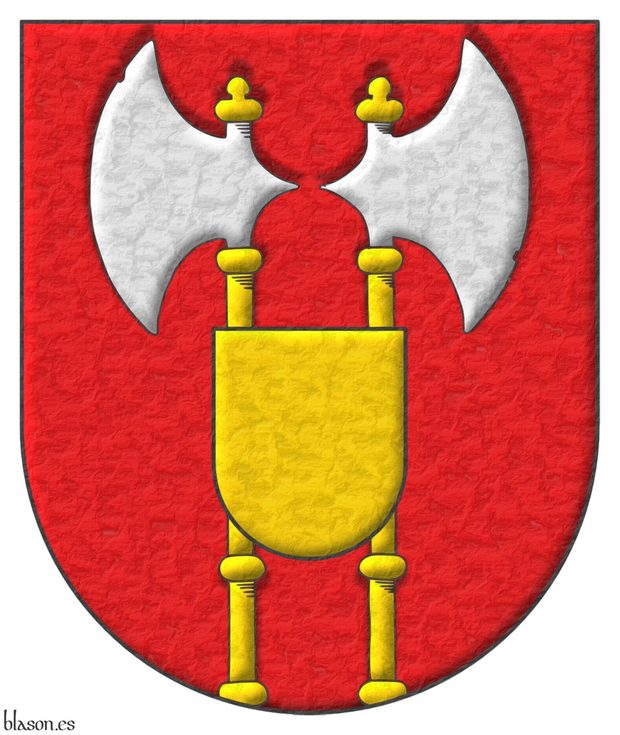
Gules, two Axes Argent, hafted Or, addorsed, issuant from the base; overall, at the nombril, an Escutcheon Or.
Escudo de gules, dos hachas adosadas de plata, fustadas de oro, movientes de la punta; brochante sobre el todo, en el ombligo, un escudete de oro.
Coat of arms interpreted with: the semicircular shape; its field illuminated with Gules; its figures and escutcheon illuminated with Or and Argent and outlined in Sable; and with a free hand texture.
At the nombril
A distinctive feature of this coat of arms is that its escutcheon, instead of being overall in the center, is positioned on a point of the coat of arms called the nombril, which, as we learn from [Avilés, J.; 1725a; page 159 and illustration 19] and also [Avilés, J.; 1780a; pages 147 and 148], in «Heraldry, the nombril of the coat of arms, is the place through which the human body receives nourishment in the mother's womb, and in the shield, it corresponds to the point where the fess ends and the base begins.».
If this escutcheon, «escudete» in Castilian, had been positioned in the center of the coat of arms, then it would have to be blazoned as the piece called an inescutcheon, «escusón» in Castilian. In fact, the Norsk Heraldisk Forening uses the English term «escutcheon» to describe the blazon of its arms.
Blazon keywords: Without divisions, Gules, Axe, Argent, Hafted, Or, Addorsed, Issuant from base, Overall, At the nombril and Escutcheon.
Style keywords: Semi-circular, Illuminated, Outlined in sable, Shaded and Soft metal.
Classification: Interpreted, Socioeconomic and Coat of arms.
Bearer: Norsk Heraldisk Forening.


Order of Alcantara, emblem
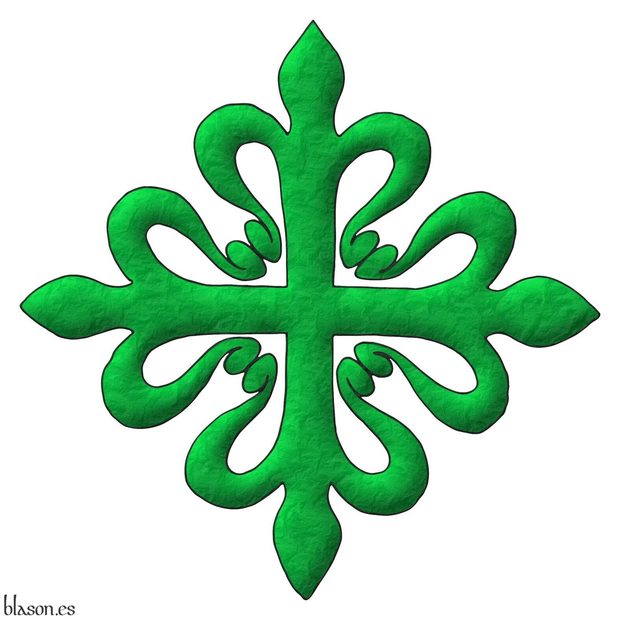
Order of Cavalry of Alcantara
A cross of Alcantara.
Una cruz de Alcántara.
Interpretation of the emblem of the order with: its cross outlined in Sable, illuminated in Vert; and a heavily beaten metal finish.
The Royal Council of the Orders of Chivalry of Santiago, Calatrava, Alcantara, and Montesa, in its historical account of the foundation of the Order of Alcantara, states that, according to Alonso de Torres y Tapia, Prior of Alcantara and a 17th-century chronicler, it was founded in 1156, by Don Suero Fernández Barrientos along with other knights from Salamanca, in Pereiro near the River Coa, under the name of the Order of Saint Julian of Pereiro and during the reign of Ferdinand II of León.
Emblem
Regarding the emblem of the Order of Cavalry of Alcantara, [Avilés, J.; 1780b; treatise IV, chapter V, page 340, figure 102], reusing the same figure 102 as for the Order of Calatrava, says «In the past, the Order of Alcantara displayed on its Standard the Gules Straps of Calatrava», remember that due to the commandery of the city of Alcantara, they had to assume some dependency on that of Calatrava, «next to a Pear tree in Vert on a field of Or, which was the insignia of the Order of Pereiro, due to the conformity with which these two Orders lived; but upon changing their Habit, the Pope» Eugene IV «granted them the green Cross», Vert, «in the manner they wear it today, differing from that of Calatrava only in color».
Blazon keywords: Cross of Alcantara, Cross couped and Cross.
Style keywords: Illuminated, Outlined in sable and Soft metal.
Classification: Interpreted, Religious, Military and Emblem.
Bearer: Alcantara, Order of.


Order of Calatrava, emblem
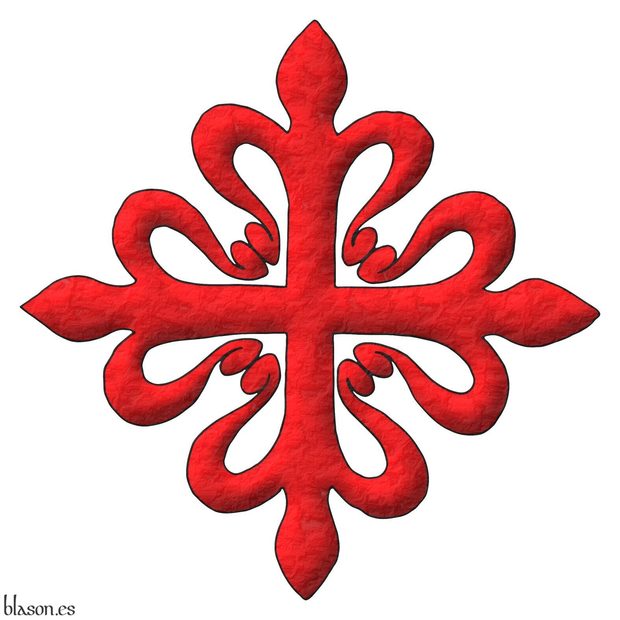
Order of Chivalry of Calatrava
A cross of Calatrava.
Una cruz de Calatrava.
Interpretation of the emblem of the order with: its cross outlined in Sable, illuminated in Gules; and a heavily beaten metal finish.
The Royal Council of the Orders of Chivalry of Santiago, Calatrava, Alcantara, and Montesa, in its historical review of the foundation of the Order of Calatrava, states that it was founded during the reign of Sancho III of Castile in the 12th century.
After the Templars withdrew from the defense of the town, King Sancho III proposed in Toledo and later confirmed in Almazán, in January 1158, the perpetual donation of the town of Calatrava to Raymond, then Abbot of the Cistercian monastery of Fitero, who, together with the former soldier Diego Velázquez, committed to defending it from attacks by the Almohads. For this mission, they received financial support from the Archbishop of Toledo, Juan, and from Toledo itself, thus managing to form an army of more than 20,000 men.
Emblem
Regarding the emblem of the Order of Chivalry of Calatrava [Avilés, J.; 1780b; treatise IV, chapter IV, page 338, figure 102] it states «the Seal was always a red cross with blue straps, and the Banner originally bore a black Cross; but today they use the red cross florety, bordered with eight circles, placed side by side, and joined at the center, formed by a cord that emerges from the leaves of the flower, which Benedict XIII gave (while recognized in Spain) and which is the Commandery that the Knights of this Order wear on their chest today, or hanging from a red ribbon on a gold medal; that is, on a field of Or a cross of Gules».
Blazon keywords: Cross of Calatrava, Cross couped and Cross.
Style keywords: Illuminated, Outlined in sable and Soft metal.
Classification: Interpreted, Religious, Military and Emblem.
Bearer: Calatrava, Order of.


Order of Montesa, emblem
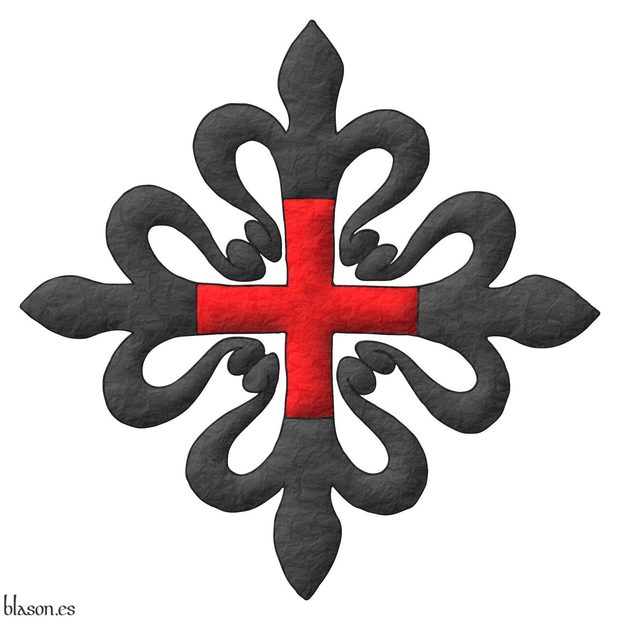
Order of Chivalry of Saint Mary of Montesa and Saint George of Alfama.
A cross of Montesa.
Una cruz de Montesa.
Interpretation of the emblem of the order with: its cross outlined in Sable, illuminated in Gules; and a highly hammered metal finish.
The Royal Council of the Orders of Chivalry of Santiago, Calatrava, Alcantara, and Montesa, in its historical review of the founding of the Order of Montesa, states that it was created in 1317, at the request of James II, King of Aragon, through a bull issued by Pope John XXII.
Emblem
About the emblem of the Order of Chivalry of Montesa [Avilés, J.; 1780b; treatise IV, chapter VI, page 342, figure 103], it states that «the Ensign of the Knights of Montesa is a plain red Cross», gules, «plain, which they wear on their Capitular Mantles, or hanging from a red ribbon on the chest over a gold oval; that is, on a field of gold a plain cross of gules (different from how the Masters wore it)» and, therefore, it describes the first emblem of the Order of Montesa and not the one they wear now, which is that same plain cross of gules charged on a cross like that of the Order of Calatrava or like that of the Order of Alcantara, but in Sable instead of Gules or Vert.
Blazon keywords: Cross of Montesa, Cross couped and Cross.
Style keywords: Illuminated, Outlined in sable and Soft metal.
Classification: Interpreted, Religious, Military and Emblem.
Bearer: Montesa, Order of.


Order of Santiago, emblem
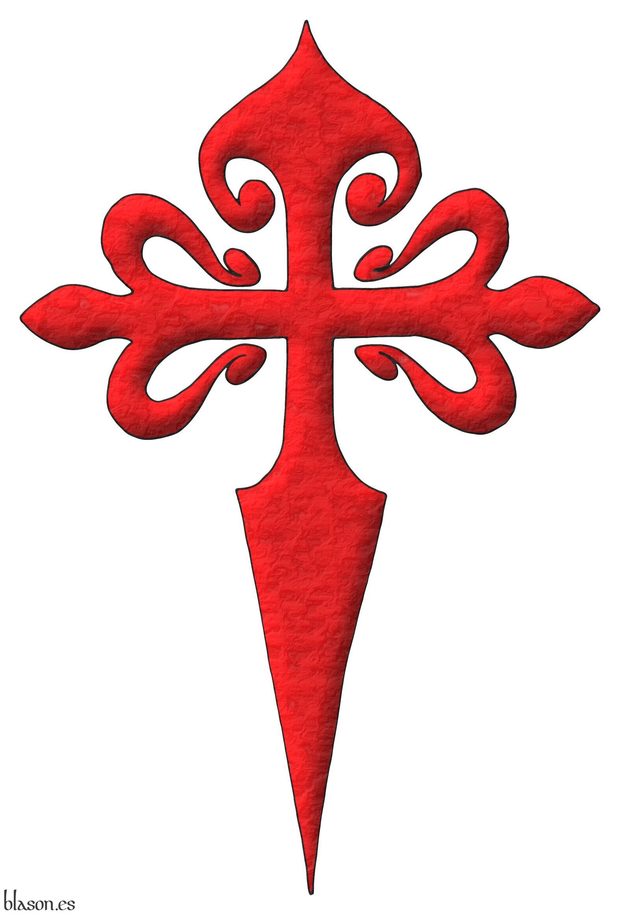
Order of Chivalry of Santiago
A cross of Saint James.
Una cruz de Santiago.
Interpretation of the emblem of the order with: its cross outlined in Sable, illuminated in Gules; and a heavily hammered metal finish.
The Royal Council of the Orders of Chivalry of Santiago, Calatrava, Alcantara, and Montesa, in its historical account of the foundation of the Order of Santiago, describes three different points of view:
- The one presented by tradition, which establishes it in 844, after the battle of Clavijo, when fourteen knights led by the Field Master Don Sancho Martínez de Tejada requested permission from Don Ramiro I, king of Asturias between the years 842 and 850, to found it. This traditional view is the one recorded in [Avilés, J.; 1780b; treatise IV, chapter II, page 325] when discussing the origin of the «Military Order of Santiago of the Sword».
- The perspective of historians like Claudio Sánchez Albornoz or Américo Castro, who question the earlier date. Furthermore, [Sánchez Albornoz, C.; 1965; pages 94-136], as cited in [Domínguez García, J.; 2008; pages 69-70], proposes that the actual battle of Clavijo occurred later, in the year 859, and that Ramiro I did not participate, but rather it was a conflict between King Ordoño I and the Moor Muza.
- The view of historians who, based on the statutes of the order found in the Monastery of Uclés, which was the residence of the Master of the Order of Santiago, and the Latin in which they are written, believe that the foundation could indeed date back to the reign of Don Ramiro I.
Emblem
Regarding the emblem of the Order of Chivalry of Santiago, [Avilés, J.; 1780b; treatise IV, chapter II, page 328, plate 25, figure 100] states «the Commandery of this Order was always a red Sword» (gules ~ red), «in the form of a Cross, just as the guards of the ancient Swords that its Knights and Commanders carried on their white Mantles, and today also on the chest in the same manner, hanging from a red ribbon on a gold medal; that is, in a field of Or, a Cross of Gules».
Blazon keywords: Cross of Saint James, Cross couped and Cross.
Style keywords: Illuminated, Outlined in sable and Soft metal.
Classification: Interpreted, Religious, Military and Emblem.
Bearer: Santiago, Order of.


Ricardo de Mandeville, soft metal
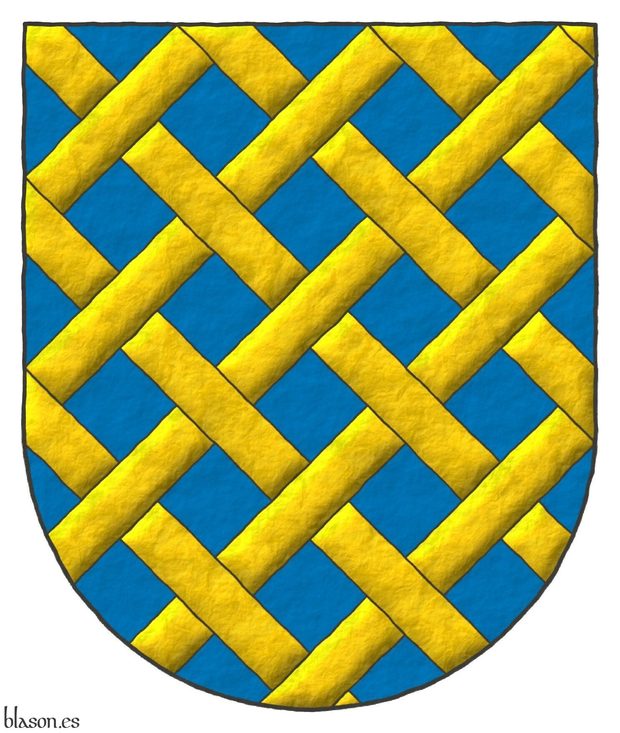
Azure fretty Or.
Escudo de azurvfretado de oro.
Blazon keywords: Without divisions, Azure, Fretty and Or.
Style keywords: Semi-circular, Illuminated, Outlined in sable, Freehand and Soft metal.
Classification: Interpreted and Personal.
Bearer: Ricardo de Mandeville.


Roger de Flor
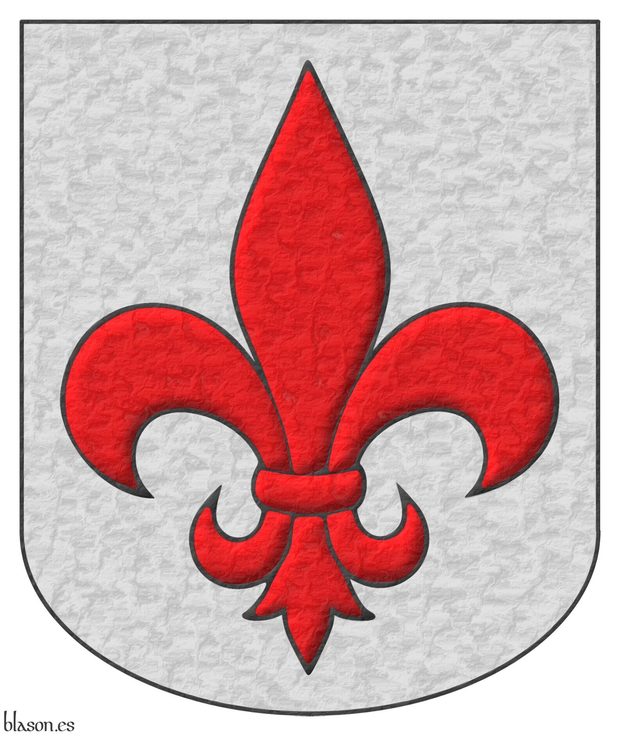
The 1st Flag of the Spanish Army Paratrooper Brigade bears his name and his coat of arms.
Argent, a fleur de lis Gules.
Escudo de plata, una flor de lis de gules.
Coat of arms interpreted with: a rounded base; a fleur de lis illuminated in Gules and outlined in Sable; and an overall lightly-hammered metal finish.
Blazon keywords: Without divisions, Argent, Gules and Fleur de lis.
Style keywords: Rounded, Illuminated, Outlined in sable and Soft metal.
Classification: Interpreted, Personal, Army and Navy and Coat of arms.
Bearer: Flor, Roger de.


Roger de Lauria
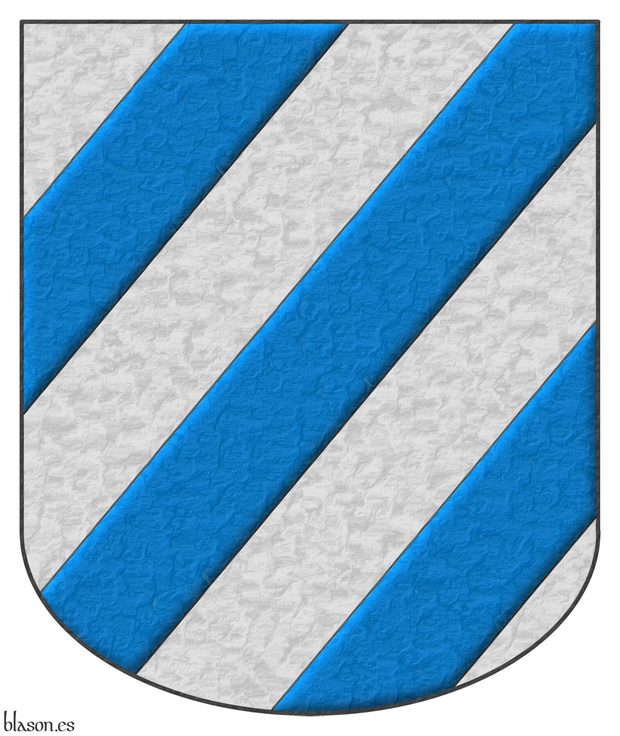
The 2nd Battalion of the Parachute Brigade of the Spanish Army bears its name and its coat of arms.
Argent, three bendlets sinister Azure.
Escudo de plata, tres barras de azur.
For the interpretation of this coat of arms, I have used: a rounded mouth; the angle I use most often, for example in bends, bendlets, bends sinister, or bendlets sinister, which is 50.2o, resulting from calculating the arctangent of 6/5, that is, the opposite side 6 divided by the adjacent side 5; with a division of the main diagonal into 7 equal parts, resulting from crossing this diagonal with the 6 lines that will form the edges of the 3 bend sinisters; and for the whole, a finish of lightly hammered metal.
Blazon keywords: Without divisions, Argent, Azure and Bend sinister.
Style keywords: Rounded, Illuminated, Outlined in sable and Soft metal.
Classification: Interpreted, Personal and Army and Navy.
Bearer: Lauria, Roger de.


Thomas Grenville, 1453-1513
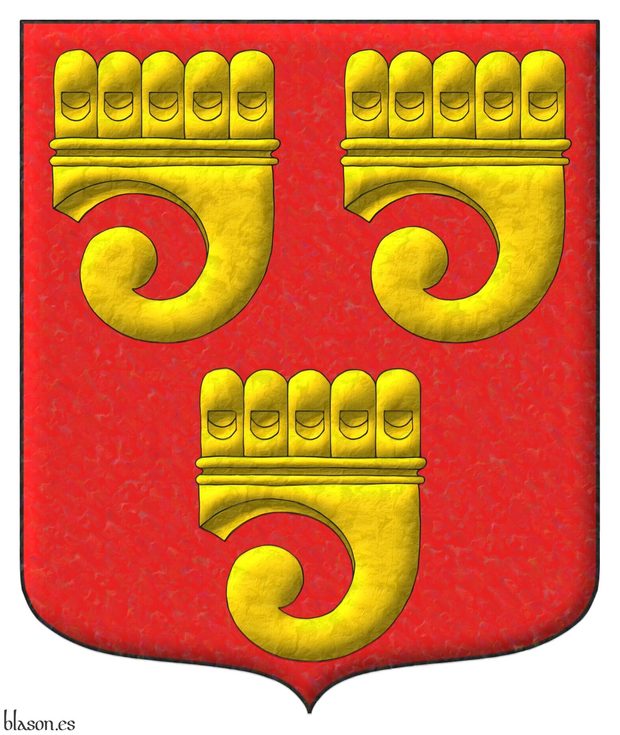
Lord of the manors of Stowe in the parish of Kilkhampton in Cornwall and of Bideford in Devon, and Sheriff of Cornwall.
Gules, three Clarions Or.
Blazon keywords: Without divisions, Gules, Three, Clarion and Or.
Style keywords: Iridescent (nacar), Soft metal, Outlined in sable and Illuminated.
Classification: Interpreted and Kingdom of England.
Bearer: Grenville, Thomas.


UBU

Purpure, a castle triple-towered Or, port and windows Azure, masoned Sable; on a chief Azure, a cross patty Or, between two escallops Argent.
Escudo de púrpura, un castillo de oro, aclarado de azur, mazonado de sable; un jefe de azur, cargado de una cruz patada de oro acompañada de dos veneras de plata.
Coat of arms interpreted as follows: with a semicircular (round) base; the field and the chief in the flat tinctures Purpure and Azure, with a lightly-hammered metal finish; and the four charges outlined in Sable, shaded, illuminated, and with a very hammered metal finish.
I hold the University Specialist degree in Real Estate Management and Administration, awarded by the Department of Private Law of the University of Burgos. These studies are structured over three academic years and are pursued online in combination with periods of traditional classes in the summers and on-site examinations during the winters. This was my first long-term online training experience.
Blazon keywords: Purpure, Or, Azure, Sable, Argent, Castle, Chief, Cross, Cross patty, Cross couped and Escallop.
Style keywords: Semi-circular, Illuminated, Shaded, Outlined in sable, Soft metal and Hard metal.
Classification: Interpreted, Socioeconomic and Education.
Bearer: Burgos, University of.


Ukraine, pointed

Azure, a Tryzub Or.
Escudo de azur, un tryzub de oro.
Interpreted coat of arms: with a pointed shape; illuminated with metals or and color azure; outlined with sable; and an iridescent finish for the field and metallic of the tryzub.
Blazon keywords: Without divisions, Azure, Trident and Or.
Style keywords: Ogee, Illuminated, Outlined in sable, Iridescent (nacar) and Soft metal.
Classification: Coat of arms, Interpreted, Civic and State of Ukraine.
Bearer: Ukraine.


University of Navarra
![University of Navarra Emblem Azure, Saint Michael Argent, vested and nimbed Or, grasping in his dexter hand a spear Or, point downward, and in his sinister hand bearing [ Gules, a chain orlewise, crosswise, and saltirewise Or, charged in the fess point with an emerald Vert, of Navarre ], upon a dragon Vert, armed, langued, fanged, and the eyes Gules.](../escudo_armas/UnavN.21.SanMiguel.Plata.Vestido.Oro.jpg)
Emblem Azure, Saint Michael Argent, vested and nimbed Or, grasping in his dexter hand a spear Or, point downward, and in his sinister hand bearing [ Gules, a chain orlewise, crosswise, and saltirewise Or, charged in the fess point with an emerald Vert, of Navarre ], upon a dragon Vert, armed, langued, fanged, and the eyes Gules.
Emblema de azur, un San Miguel de plata, vestido y nimbado de oro, teniendo en su diestra una lanza de oro, con la punta hacia abajo y en su siniestra trae [ escudo gules, una cadena puesta en orla, en cruz y en sotuer de oro, cargada en el centro de una esmeralda de sinople, de Navarra ], sostenido por un dragón de sinople, armado, lampasado, fierezado y encendido de gules.
Emblem interpreted by me as follows: an oval shape with proportions 5x6, wider than the original; the field illuminated in Azure; its charges outlined in Sable and illuminated in the colours Gules and Vert and the metals Argent and Or; the Archangel Saint Michael vested in Or, unlike others who appear in Argent; his emerald simplified into an area enameled Vert; and the whole emblem has a lightly beaten metal finish.
Due to its special characteristics, the difficulty in complying with the first rule of heraldry concerning metals and colours, and out of prudence, I categorize it as an emblem rather than a shield.
In a relief of the Church of Saint Michael the Archangel in Estella, Saint Michael can be seen fighting a dragon that represents the devil, in a similar but mirrored arrangement to that of this emblem. In that relief, the Archangel Saint Michael bears a pre-heraldic shield with its umbo. According to [Menéndez Pidal de Navascués, F.; 1963], the umbo of the shield is a reinforcing element that is the predecessor of what would later become the pommelly carbuncle of the shield of the Kingdom of Navarre.
Blazon keywords: Without divisions, Azure, Male figure, Angel, Archangel, Argent, Vested, Nimbed, Or, Grasping, Dexter, Spear, Point downwards, Sinister, Gules, One, Chain, Orlewise, Crosswise, Saltirewise, Charged, In the fess point, Emerald, Vert, Upon, Dragon, Armed, Langued, The fangs and The eyes.
Style keywords: Oval, Illuminated, Outlined in sable and Soft metal.
Classification: Interpreted, Socioeconomic, Education, Emblem and Kingdom of Navarre.
Bearer: University of Navarra.


Walker, Peter Edward

Baron Walker of Worcester
Party per pale Sable and Or semé of portcullises and three turreted towers all counterchanged.
Escudo partido de sable y oro sembrado del uno al otro de rastrillos y torres tridonjonadas.
Illuminated with lights and shadows and with a metallic finish.
Coat of arms of Peter Edward Walker, Baron Walker of Worcester, emblazoned by me in 4 steps, notice that it is a double semé.
Blazon keywords: Party per pale, Sable, Or, Semé, Counterchanged, Portcullis, Tower, With a turret, Three and Turret.
Style keywords: Soft metal, Outlined in sable, Illuminated and Pointed.
Classification: Interpreted and Schema.
Bearer: Walker, Peter Edward.

William Shakespeare, lanza de torneo

Or, on a bend Sable, a spear of the first, steeled Argent.
Escudo de oro, una banda de sable, cargada de una lanza de plata, fustada oro.
Coat of arms interpreted by me with: a semicircular (round) base; the field and bend illuminated in Or and Sable; the lance is a tournament one, similar to other Shakespeare coats of arms, which I have illuminated in Argent and Or and outlined from the field; and finished with a lightly hammered metal effect.
In this version of his blazon in English I have written «steeled Argent», which is how some authors write it, while in another article I have specified it as «headed Argent».
In the figure that is charged upon the bend of this interpretation of the shield, I recreate a tournament lance, which is the type usually used to represent the arms of William Shakespeare. Note that the blazon of his shield only indicates «a Spear» ~ «una lanza», so it could equally be the type of lance used by infantry or light cavalry. However, English tradition usually employs, for William Shakespeare, a tournament lance, both for the one charged on the bend and for the one held by the falcon on his crest.
Blazon keywords: Without divisions, Or, Sable, Argent, Bend, Bendwise, Spear and Charged.
Style keywords: Soft metal, Outlined in the field tincture and Illuminated.
Classification: Interpreted, Personal, Coat of arms, Canting and Literature.
Bearer: Shakespeare, William.
-
Language
-
Categories of heraldry
-
Divisions of the field
- Without divisions
- Party per pale
- Party per fess
- Party per bend
- Party per bend sinister
- Tierce
- Tierce sinister
- Tierced per pale
- Tierced per fess
- Tierced per bend
- Tierced pallwise inverted
- Quarterly
- Quarterly per saltire
- Gyronny
- Party per fess, the chief per pale
- Party per pale, the sinister per fess
- Party per fess, the base per pale
- Party per pale, the dexter per fess
- Chapé
- Chaussé
- Embrassé
- Contre-embrassé
- Party per chevron
- Enté
- Enté en point
- Flanched
-
Metals
-
Colours
-
Furs
-
Other tinctures
-
Ordinaries and sub-ordinaries
-
Diminutives of the ordinaries
-
Geometric charges
-
Composite ordinaries
-
Inanimate charges from Nature
Atom, Crescent, Diamond, Emerald, Estoile, Increscent, Lightning flash, Moon, Mount, Mullet, Mullet of four points, Orbital, Plough of Ursa Major, Rainbow, Ray of the sun, River, Sea, Snowflake, Sun, Sun in splendour, Sun of May, Trimount, Water and Wave.
-
Vegetal charges from Nature
Acorn, Apple, Apple tree, Ash, Bluebonnet, Camellia, Chrysanthemum, Cinquefoil, Cornflower, Dogwood flower, Double rose, Elm, Fleur de lis, Flower, Gourd, Holm oak, Hop cone, Kapok tree, Laurel, Lily, Linden, Lotus flower, Madonna lily, Mexican cedar tree, Oak, Olive tree, Palm tree, Plantain plant, Pomegranate, Poplar leaf, Rose, Shamrock, Sunflower, Thistle, Tree, Tulip, Vine and Wheat.
-
Animal charges from Nature
Badger, Bald eagle, Barbel, Barn owl, Bear, Beaver, Beetle, Bighorn sheep, Blackbird, Boar, Brach hound, Bull, Doe, Dog, Dolphin, Dove, Eagle, Elephant, Falcon, Female figure, Fish, Flame, Fly, Fox, Frog, Goat, Goldfinch, Goose, Heron, Horse, Hummingbird, Jaguar, Lark, Leopard, Lion, Lion passant, Lion rampant guardant, Lioness, Lynx, Male figure, Martlet, Merino ram, Owl, Panther, Parrot, Peacock, Pelican, Pelican in her piety, Puffin, Quetzal, Raven, Roe deer, Rooster, Savage, Seagull, Serpent, She-wolf, Stag, Starling, Talbot, Tyger, Vulture, Warren hound and Wolf.
-
Parts of natural charges
Arm, Beak, Branch, Caboshed, Chest, Claw, Covert, Dorsal fin, Eagle claw, Ermine spot, Escallop, Feather, Foot (palmiped), Foreleg, Forepaw, Hand, Head, Heart, Hoof, Leaf, Neck, Ostrich feather, Palm frond, Paw, Roe deers' attires, Shoulder, Sprig, Stags' attires, Stem, Swallow-tail, Tail, Tail addorsed, Tail fin, Talon, Tooth, Trunk, Trunk (elephant), Two hands clasped, Two wings in vol, Udder, Wheat spike, Wing and Wrist.
-
Artificial charges
Ace of spades, Anchor, Anvil, Arch, Arm vambraced, Armillary sphere, Arrow, Axe, Bell, Bell tower, Beret, Bonfire, Book, Bookmark, Bow, Branding iron, Bridge, Broken, Buckle, Cannon, Cannon dismounted, Cannon port, Canopy roof, Carbuncle, Castle, Celtic Trinity knot, Chain, Chess rooks, Church, Clarion, Clay pot, Closed book, Club, Column, Comb, Compass rose, Conductor's baton, Cord, Covered cup, Crozier, Crucible, Cuffed, Cup, Cyclamor, Dagger, Double vajra, Drum, Ecclesiastical cap, Fanon, Federschwert, Fleam, Four crescents joined millsailwise, Galician granary, Garb, Gauntlet, Geometric solid, Grenade, Halberd, Hammer, Harp, Host, Hourglass, Key, Key ward, Knight, Knot, Lantern, Letter, Line, Loincloth, Menorah, Millrind, Millstone, Millwheel, Monstrance, Mortar, Mullet of six points pierced, Nail, Non-classic artifact, Norman ship, Number, Oar, Oil lamp, Open book, Page, Pair of scales, Parchment, Pestle, Piano, Pilgrim's staff, Plough share, Polish winged hussar, Port, Portcullis, Potent, Quill, Ribbon, Rosette of acanthus leaves, Sabre, Sackbut, Sail, Scroll, Scythe, Sheaf of tobacco, Ship, Skirt, Spear, Spear's head, Stairway, Star of David, Step, Sword, Symbol, Tetrahedron, Torch, Tower, Trident, Trumpet, Turret, Two-handed sword, Wagon-wheel, Water-bouget, Wheel, Winnowing fan and With a turret.
-
Immaterial charges
Angel, Archangel, Basilisk, Dragon, Dragon's head, Garuda, Golden fleece, Griffin, Heart enflamed, Justice, Mermaid, Our Lady of Mercy, Ouroboros, Paschal lamb, Pegasus, Phoenix, Sacred Heart of Jesus, Saint George, Sea-griffin, Trinity, Triton, Unicorn, Winged hand and Wyvern.
-
External elements
-
Heraldic creations
-
References
-
Formats
-
Keywords on this page
Iridescent (nacar), Armed, Azure, Bend sinister, Overall, Charged, Castle, Crest, Five, Ogee, Crown, Closed royal crown, Created, Cross, Cross of Alcantara, Cross of Calatrava, Cross of Montesa, Cross couped, Quarterly, Counterchanged, Outlined in sable, Outlined in the field tincture, Dexter, Motto (identification), Army and Navy, Emblem, Coat of arms, Fleur de lis, Personal, Gules, Illuminated, Interpreted, Motto, Semi-circular, Soft metal, Military, Or, Argent, Without divisions, Civic, Rounded, Religious, Sable, Semé, Vert, Socioeconomic, Shaded, Three and One.


